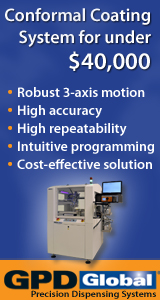Printed Circuit Board Assembly & PCB Design Forum
SMT electronics assembly manufacturing forum.
- SMTnet
- »
- Electronics Forum
- »
- BGA rework
BGA rework
![]() Hello All, I've got a little problem here. I have a 456 ba...
- May 14, 2002
by
RDR
Hello All, I've got a little problem here. I have a 456 ba...
- May 14, 2002
by
RDR
![]()
![]()
![]() Maybe the issue is not a proper rework method. Your shorts ...
- May 14, 2002
by
davef
Maybe the issue is not a proper rework method. Your shorts ...
- May 14, 2002
by
davef
![]()
![]()
![]() Good point, I am preheating for 90 sec to a temp of 170 C. (...
- May 15, 2002
by
RDR
Good point, I am preheating for 90 sec to a temp of 170 C. (...
- May 15, 2002
by
RDR
![]()
![]()
![]() 2 suggestions -
Get a good scope - at least a 4X, but mor...
- May 22, 2002
by
2 suggestions -
Get a good scope - at least a 4X, but mor...
- May 22, 2002
by
![]()
![]()
![]() I use the exact same paste flux that we use in our solder pa...
- May 27, 2002
by
Reworkman
I use the exact same paste flux that we use in our solder pa...
- May 27, 2002
by
Reworkman
![]()
- SMTnet
- »
- Electronics Forum
- »
- BGA rework








